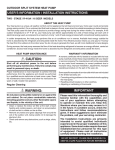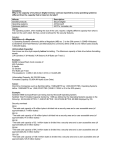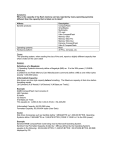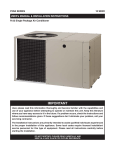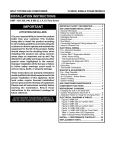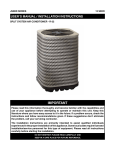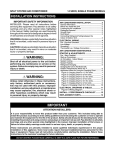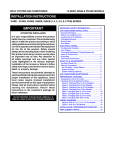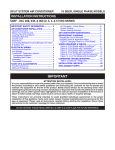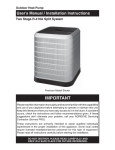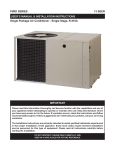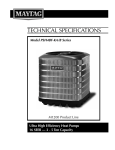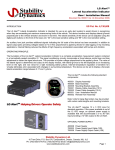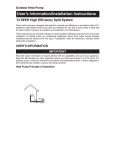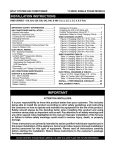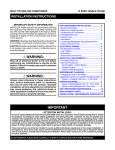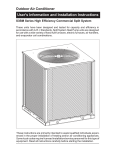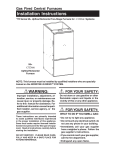Download T4BF-KA Split System Heat Pump - eNora
Transcript
Outdoor Split System Heat Pump USER’s INFORMATION / Installation Instructions Two - Stage | R-410A | 16 SEER MODELS About the Heat Pump Your heat pump is a unique, all weather comfort-control appliance that will heat and cool your home year round and provide energy saving comfort. It’s an unknown fact that heat is always in the air, even when the outside temperature is below freezing. The heat pump uses this basic law of physics to provide energy saving heat during the winter months. For example, If the outdoor temperature is 47° F (8° C), your heat pump can deliver approximately 3.5 units of heat energy per each unit of electrical energy used, as compared to a maximum of only 1 unit of heat energy produced with conventional heating systems. In colder temperatures, the heat pump performs like an air conditioner run in reverse. Available heat energy outside the home is absorbed by the refrigerant and exhausted inside the home. This efficient process means you only pay for “moving” the heat from the outdoors to the indoor area. You do not pay to generate the heat, as with more traditional furnace designs. During summer, the heat pump reverses the flow of the heat-absorbing refrigerant to become an energy-efficient, central air conditioner. Excess heat energy inside the home is absorbed by the refrigerant and exhausted outside the home. HEAT PUMP MAINTENANCE CAUTION: Shut off all electrical power to the unit before performing any maintenance. Failure to comply may result in personal injury or death. Proper maintenance is most important to achieve the best performance from the appliance and should be performed by a qualified service technician at least once a year. Read the maintenance items below and follow the instructions for years of safe, trouble free operation. Regular Cleaning WARNING: Do not place combustible material on or against the unit cabinet. Do not place combustible materials, including gasoline and any other flammable vapors and liquids, in the vicinity of the unit. • Clean or replace the indoor air filter at the start of each heating and cooling season, and when an accumulation of dust and dirt is visible on the air filter. • Remove any leaves and grass clippings from around the coil of the outdoor unit, being careful not to damage the aluminum fins. • Check and remove any obstructions, such as twigs, sticks, etc. Warranty Information A warranty certificate with full details is included with the heat pump. Carefully review these responsibilities with your dealer or service company. The manufacturer will not be responsible for any costs found necessary to correct problems due to improper setup, improper installation, adjustments, improper operating procedure on the part of the user, etc. Some specific examples of service calls which are not included in the limited warranty are: • Correcting wiring problems in the electrical circuit supplying the heat pump. • Resetting circuit breakers or other switches. • Adjusting or calibrating of thermostat. IMPORTANT Please read this information thoroughly and become familiar with the capabilities and use of your appliance before attempting to operate or maintain this unit. Keep this literature where you have easy access to it in the future. If a problem occurs, check the instructions and follow recommendations given. If these suggestions don’t eliminate the problem, call your servicing contractor. The Installation Instructions are primarily intended to assist qualified individuals experienced in the proper installation of this appliance. Some local codes require licensed installation/service personnel for this type of equipment. Please read all instructions carefully before starting the installation. DO NOT DESTROY! PLEASE READ CAREFULLY & KEEP IN A SAFE PLACE FOR FUTURE REFERENCE USER’s INFORMATION Operating Instructions Please refer to the thermostat manufacturer’s User manual for detailed programming instructions. Cooling Operation Only 1.Set the thermostat’s system mode to COOL or AUTO and change the fan mode to AUTO. See Figure 1 2.Set the temperature selector to the desired temperature level.The outdoor fan, compressor, and blower motor will all cycle on and off to maintain the indoor temperature at the desired cooling level. NOTE: If the temperature level is re-adjusted, or the system mode is reset, the fan and compressor in the outdoor unit may not start immediately. A protective timer circuit holds the compressor and the outdoor fan off for approximately three minutes following a previous operation or the interruption of the main electrical power. Heating Operation Only 1.Set the thermostat’s system mode to HEAT or AUTO and change the fan mode to AUTO. See Figure 1. 2.Set the temperature selector to the desired temperature level. The compressor, outdoor fan, and blower motor will cycle on and off to maintain the indoor temperature at the desired heating level. NOTE: If the temperature level is re-adjusted, or the system mode is reset, the fan and compressor in the outdoor unit may not start immediately. A protective timer circuit holds the compressor and the outdoor fan off for approximately three minutes following a previous operation or the interruption of the main electrical power. Emergency Heat Some thermostats may include a system mode called EM HT or AUX HT, etc. This is a back-up heating mode that should only be used if a problem is suspected. With the mode set to EM HT, etc., the compressor and outdoor fan will be locked off and supplemental heat (electric resistance heating) will be used as a source of heat. Sustained use of electric resistance heat in place of the heat pump will result in an increase in electric utility costs. and begin to heat the outdoor coil causing the ice and snow to melt. NOTE: While the ice and snow is melting, some steam may rise from the outdoor unit as the warm coil causes the melting frost to evaporate. When defrost is completed, the outdoor fan motor will start, and the compressor will turn off again. In approximately 30 seconds the compressor will start up again and continue normal operation. Operating the Heat Pump for Automatic Cooling & Heating 1.Set the thermostat system switch to AUTO and the thermostat fan switch to AUTO. See Figure 1. NOTE: Thermostats will vary. Some models will not include the AUTO mode, and others will have the AUTO in place of the HEAT and COOL, and some will include all three. 2.Set the thermostat temperature to the desired heating and cooling temperature level(s). The outdoor unit and the indoor blower will then cycle on and off in either the heating or cooling mode of operation as required to automatically maintain the indoor temperature within the desired limits. Operating the Indoor Blower Continuously The continuous indoor blower operation is typically used to circulate the indoor air to equalize a temperature unbalance due to a sun load, cooking, or fireplace operation. Set the thermostat fan mode to ON (Figure 1). The indoor blower starts immediately, and will run continually until the fan mode is reset to AUTO. The continuous indoor blower operation can be obtained with the thermostat system mode set in any position, including OFF. Shutting the Heat Pump Off Change the thermostat’s system mode to OFF and the fan mode to AUTO. See Figure 1. NOTE: The system will not operate, regardless of the temperature selector setting. Defrost Operation During cold weather heating operation, the outdoor unit will develop a coating of snow and ice on the heat transfer coil. This is normal and the unit will defrost itself. This unit features Adaptive Demand Defrost that monitors ambient and coil temperatures to regulate the defrost function accordingly. At the beginning of the defrost cycle, both the outdoor condenser fan and compressor will turn off. After approximately 30 seconds, the compressor will turn on 2 Fan Mode System Mode Temperature Selector Figure 1. Digital Thermostat INSTALLER INFORMATION ONLY Important Safety Information.....................................4 Pressures Within the System.....................................4 Labels, Tags, and Precautions...................................4 Brazing Operations.....................................................4 Heat Pump Installation................................................5 General Information....................................................5 Before You Install this Unit..........................................5 Locating the Heat Pump.............................................5 Packaging Removal....................................................5 Ground Level..............................................................5 Roof Mount.................................................................5 Connecting Refrigerant Tubing between the Indoor & Outdoor Unit................................................6 Electrical Wiring...........................................................6 Pre - Electrical Checklist............................................6 Line Voltage................................................................6 Grounding..................................................................7 Thermostat Connections............................................7 Outdoor Unit Connections..........................................7 Control Circuit Wiring.................................................7 Comfort AlertTM Diagnostics Module..........................7 24VAC Power Wiring...............................................8 Thermostat Demand Wiring....................................8 Interpreting the Diagnostic LED’s............................8 LED Description......................................................8 Outdoor Fan Motor.....................................................8 Optional Equipment....................................................8 Transformer Upgrade Kit.........................................8 Startup & Adjustments...............................................9 Pre - Start Checklist...................................................9 Startup-Procedures....................................................9 Air Circulation - Indoor Blower................................9 System Heating.......................................................9 System Cooling.......................................................9 Adjustment of Refrigerant Charge..............................9 Charging an R-410A System in AC Mode at Outdoor Temperatures above 55° F......................10 Charging an R-410A Unit in Heat Mode...............10 Short Cycle Protection.............................................10 Defrost Cycle Control...............................................10 Defrost Test Procedure.............................................11 Anti Short Cycle Timer Test......................................11 Heating Mode........................................................11 Cooling Mode........................................................11 Optional Equipment..................................................11 Component Functions..............................................11 Component Functions..............................................11 Replacement Parts....................................................11 Unit Dimensions........................................................12 Figure 5. Unit Dimensions........................................12 Cooling Charging Charts..........................................13 Figure 6. Cooling Chart for 2 Ton Units....................13 Figure 7. Cooling Chart for 3 Ton Units....................13 Figure 8. Cooling Chart for 4 Ton Units....................14 Figure 9. Cooling Chart for 5 Ton Units....................14 Heating Charging Chart............................................15 Figure 10. Heating Chart..........................................15 Wiring Diagrams........................................................16 Figure 11. Standard Models (2 Ton).........................16 Figure 12. Standard Models (3 Ton).........................17 Figure 13. Standard Models (4 & 5 Ton)...................18 Figure 14. Premium / Ultra Models (2 Ton)...............19 Figure 15. Premium / Ultra Models (3 Ton)...............20 Figure 16. Premium / Ultra Models (4 & 5 Ton)........21 Comfort Alert Troubleshooting Charts....................22 Table 4. LED Diagnostics.........................................22 Table 5. Module Wiring Troubleshooting...................24 3 important SAFETY INFORMATION INSTALLER: Please read all instructions before servicing this equipment. Pay attention to all safety warnings and any other special notes highlighted in the manual. Safety markings are used frequently throughout this manual to designate a degree or level of seriousness and should not be ignored. WARNING indicates a potentially hazardous situation that if not avoided, could result in personal injury or death. CAUTION indicates a potentially hazardous situation that if not avoided, may result in minor or moderate injury or property damage. WARNING: Shut off all electrical power to the unit before performing any maintenance or service on the system. Failure to comply may result in personal injury or death. WARNING: Unless noted otherwise in these instructions, only factory authorized parts or accessory kits may be used with this product. Improper installation, service, adjustment, or maintenance may cause explosion, fire, electrical shock or other hazardous conditions which may result in personal injury or property damage WARNING: Please follow all charging instructions for maximum unit performance and efficiency. Some local codes require licensed installation/service personnel to service this type of equipment. Refrigerant charging must be done by qualified personnel familiar with safe and environmentally responsible refrigerant handling procedures. Under no circumstances should the owner attempt to install and/or service this equipment. Failure to comply with this warning could result in property damage, personal injury, or death. 4 CAUTION: This unit uses R-410A refrigerant. DO NOT use any other refrigerant in this unit. Use of another refrigerant will damage the unit. WARNING: The information listed below must be followed during the installation, service, and operation of this unit. Unqualified individuals should not attempt to interpret these instructions or install this equipment. Failure to follow safety recommendations could result in possible damage to the equipment, serious personal injury or death. • The installer must comply with all local codes and regulations which govern the installation of this type of equipment. Local codes and regulations take precedence over any recommendations contained in these instructions. Consult local building codes and the National Electrical Code (ANSI CI) for special installation requirements. • All electrical wiring must be completed in accordance with local, state and national codes and regulations and with the National Electric Code (ANSI/NFPA 70) or in Canada the Canadian Electric Code Part 1 CSA C.22.1. • This equipment contains liquid and gaseous refrigerant under high pressure. DO NOT USE ANY PORTION OF THE CHARGE FOR PURGING OR LEAK TESTING.Installation or servicing should only be performed by qualified trained personnel thoroughly familiar with this type equipment. • Fully annealed, refrigerant grade copper tubing should be used when installing the system. Refrigerant suction line tubing should be fully insulated. • Installation of equipment may require brazing operations. Installer must comply with safety codes and wear appropriate safety equipment (safety glasses, work gloves, fire extinguisher, etc.) when performing brazing operations. • This unit is designed for outdoor installations only and should be located as descibed on page 5. • Follow all precautions in the literature, on tags, and on labels provided with the equipment. Read and thoroughly understand the instructions provided with the equipment prior to performing the installation and operational checkout of the equipment. Heat Pump INSTallATION General Information Split system heat pumps are designed only for outdoor rooftop or ground level installations. This unit has been tested for capacity and efficiency in accordance with AHRI. Standards and will provide many years of safe and dependable comfort, providing it is properly installed and maintained. Abuse, improper use, and/or improper maintenance can shorten the life of the appliance and create unsafe hazards. Packaging Removal To prevent damage to the tubing connections, carefully remove the carton and user’s manual from the equipment. Discard the shipping carton. Ground Level To achieve optimum performance and minimize equipment failure, it is recommended that periodic maintenance be performed on this unit. The ability to properly perform maintenance on this equipment requires certain mechanical skills and tools. Ground level installations must be located according to local building codes or ordinances and these requirements: • Clearances must be in accordance with those shown in Figure 2. • A suitable mounting pad must be provided and separate from the building foundation. The pad must be level and strong enough to support the weight of the unit. The slab height must be a minimum of 2” (5 cm) above grade and with adequate drainage. See Figure 2. Before You Install this Unit Roof Mount √The cooling load of the area to be conditioned must be calculated and a system of the proper capacity selected. It is recommended that the area to be conditioned be completely insulated and vapor sealed. √ Check the electrical supply and verify the power supply is adequate for unit operation. The system must be wired and provided with circuit protection in accordance with local building codes. If there is any question concerning the power supply, contact the local power company. √ The indoor section (air handler, furnace, etc) should be installed before routing the refrigerant tubing. Refer to the indoor unit's installation instructions for installation details. √ All units are securely packed at the time of shipment and upon arrival should be carefully inspected for damage prior to installing the equipment at the job site. Verify coil fins are straight. If necessary, comb fins to remove flattened or bent fins. Claims for damage (apparent or concealed) should be filed immediately with the carrier. √Please consult your dealer for maintenance information and availability of maintenance contracts. Please read all instructions before installing the unit. • The method of mounting should be designed so that it does not overload roof structures or transmit noise to the interior of the structure.The roof must be structurally capable of handling the weight of the unit. • Full perimeter support is required under the unit. Support must be made of weather resistant materials and installed prior to unit installation. • The support must be built to raise the unit 6” above the roof. 6” from Building or Structure 24" for Service Access 12" or 18” See Note 12" or 18” See Note DO NOT OBSTRUCT TOP OF UNIT NOTE: Units require full perimeter clearances. Installer must maintain 18” between two units or 12” between single unit and structure. Locating the Heat Pump • Survey the job site to determine the best location for mounting the outdoor unit. See Figure 5 (page 12) for unit dimensions. • Overhead obstructions (Figure 2), poorly ventilated areas, and areas subject to accumulation of debris should be avoided. • Sufficient clearance for unobstructed airflow through the outdoor coil must be maintained in order to achieve rated performance. See Figure 2 for minimum clearances to obstructions. • Consideration should be given to availability of electric power, service access, noise, and shade. 48” 2” Mounting Pad Figure 2. Clearance Requirements 5 Connecting Refrigerant Tubing Between the Indoor & Outdoor Unit CAUTION: This system uses R-410A refrigerant with POE oil. When servicing, cover or seal openings to minimize the exposure of the refrigerant system to air to prevent accumulation of moisture and other contaminants. After outdoor and indoor unit placement has been determined, route refrigerant tubing between the equipment in accordance with sound installation practices. • When connecting refrigerant linesets together, it is recommended that dry nitrogen be flowing through the joints during brazing to prevent internal oxidation and scaling. • Refrigerant tubing should be routed in a manner that minimizes the length of tubing and the number of bends in the tubing. If precise forming of refrigerant lines is required, a copper tubing bender is recommended. Avoid sharp bends and contact of the refrigerant lines with metal surfaces. • Refrigerant tubing should be supported in a manner that the tubing will not vibrate or abrade during system operation. • Tubing should be kept clean of foreign debris during installation. • Every effort should be made by the installer to ensure that the field installed refrigerant containing components of the system have been installed in accordance with these instructions and sound installation practices to insure reliable system operation and longevity. • The maximum recommended interconnecting refrigerant line lengths is 75 ft. and the vertical COPPER WIRE SIZE — AWG (1% Voltage Drop) Supply Wire Length-Feet 200 6 4 4 4 3 3 2 2 2 1 150 8 6 6 4 4 4 3 3 3 2 100 10 8 8 6 6 6 4 4 4 3 50 14 12 10 10 8 8 6 6 6 4 Supply Circuit Ampacity 15 20 25 30 35 40 45 50 55 60 Wire Size based on N.E.C. for 60° type copper conductors. Table 1. Copper Wire Size 6 elevation difference between the indoor and outdoor sections should not exceed 20 ft. • To maintain the unit’s warranty, it is required that a filter drier be installed when the system is open to the atmosphere. This includes, but is not limited to, replacing the evaporator and/or condenser of a system. The filter drier must be installed in strict accordance with the manufacturer’s installation instructions. • Optional equipment such as liquid line solenoid valves, low ambient, etc., should be installed in strict accordance with the manufacturer’s installation instructions. ELECTRICAL WIRING WARNING: To avoid risk of electrical shock, personal injury, or death, disconnect all electrical power to the unit before performing any maintenance or service. The unit may have more than one electrical supply. Label all wires prior to disconnection when servicing the unit. Wiring errors can cause improper and dangerous operation. • All electrical connections must be in compliance with all applicable local codes and ordinances, and with the current revision of the National Electric Code (ANSI/NFPA 70). • For Canadian installations the electrical connections and grounding shall comply with the current Canadian Electrical Code (CSA C22.1 and/or local codes). Pre-Electrical Checklist √ Verify that the voltage, frequency, and phase of the supply source match the specifications on the unit rating plate. √Verify that the service provided by the utility is sufficient to handle the additional load imposed by this equipment. Refer to the unit wiring label for proper voltage wiring. √ Verify factory wiring is in accordance with the unit wiring diagram or Figures 11 - 16 (pages 16 - 21). Check for loose connections. Line Voltage • A wiring diagram is located on the inside cover of the electrical box of the outdoor unit. The installer should become familiar with the wiring diagram before making any electrical connections to the outdoor unit. • An electrical disconnect must be located within sight of and readily accessible to the unit. This switch shall be capable of electrically de-energizing the outdoor unit. • Line voltage to the unit should be supplied from a dedicated branch circuit containing the correct fuse or circuit breaker for the unit. Incoming field wiring and minimum size of electrical conductors and circuit protection must be in compliance with information listed on the outdoor unit data label. Any other wiring methods must be acceptable to authority having jurisdiction. • The outdoor unit requires both power and control circuit electrical connections. Refer to the wiring diagram / schematic for identification and location of outdoor unit field wiring interfaces or see Figures 11 16 (pages 16 - 21). Make all electrical connections in accordance with all applicable codes and ordinances. • Overcurrent protection must be provided at the branch circuit distribution panel and sized as shown on the unit rating label and according to applicable local codes. See the unit rating plate for minimum circuit ampacity and maximum overcurrent protection limits. • Provide power supply for the unit in accordance with the unit wiring diagram, and the unit rating plate. Connect the line-voltage leads to the terminals on the contactor inside the control compartment. • Use only copper wire for the line voltage power supply to this unit as listed in Table 1 (page 6). Use proper code agency listed conduit and a conduit connector for connecting the supply wires to the unit. Use of rain tight conduit is recommended. • 208/230 Volt units are shipped from the factory wired for 230 volt operation. For 208V operation, remove the lead from the transformer terminal marked 240V and connect it to the terminal marked 208V. Thermostat NOTE: Jumper W1 & W2 together for shorter staging time. G R W2 C E O Y1 Y2 W1 W3 Y1 W2 W1 R W2 E O OD Stat C O Y1 Y2 Y/Y2 G R C Air Handler Heat Pump OD Section Figure 3. Typical 2 - Stage Heat Pump w/ Optional Outdoor Thermostat and Variable Speed Air Handler • Optional equipment requiring connection to the power or control circuits must be wired in strict accordance of the NEC (ANSI/NFPA 70), applicable local codes, and the instructions provided with the equipment. Grounding WARNING: The unit cabinet must have an uninterrupted or unbroken electrical ground to minimize personal injury if an electrical fault should occur. Do not use gas piping as an electrical ground! This unit must be electrically grounded in accordance with local codes or, in the absence of local codes, with the National Electrical Code (ANSI/NFPA 70) or the CSA C22.1 Electrical Code. Use the grounding lug provided in the control box for grounding the unit. Thermostat Connections • Thermostat connections should be made in accordance with the instructions supplied with the thermostat and the indoor equipment. • The outdoor unit is designed to operate from a 24 VAC Class II control circuit. The control circuit wiring must comply with the current provisions of the NEC (ANSI/NFPA 70) and with applicable local codes having jurisdiction. • The low voltage wires must be properly connected to the units low voltage terminal block (Figure 3). Recommended wire gauge and wire lengths for typical thermostat connections are listed in Table 2. • The thermostat should be mounted about 5 feet above the floor on an inside wall. DO NOT install the thermostat on an outside wall or any other location where its operation may be adversely affected by radiant heat from fireplaces, sunlight, or lighting fixtures, and convective heat from warm air registers or electrical appliances. Refer to the thermostat manufacturer’s instruction sheet for detailed mounting and installation information. Comfort AlertTM Diagnostics Module (Select Models Only) The Comfort AlertTM Diagnostics Module (Figure 5, page 8) is a breakthrough innovation for troubleshooting heat pump and air conditioning system failures. The module installs easily in the electrical box of the outdoor unit near the compressor contactor. By monitoring and analyzing data from the Copeland scroll compressor and the thermostat demand, the module can accurately detect the cause of electrical and system related failures without any sensors. A flashing LED indicator communicates the ALERT code and a diagnostic key is also imprinted on the side of the module to quickly direct the technician to the root cause of a problem. NOTE: This module does not provide safety protection! The Comfort AlertTM Diagnostics 7 Each time the module powers up, the last ALERT Flash Code that occurred prior to shut down is displayed for one minute. The module will continue to display the LED until the condition returns to normal or if 24 VAC power is removed from the module. See Table 4 (page 21) for flash code identification or Table 5 (page 23) for module wiring troubleshooting. POWER LED (Green) Diagnostics Key ALERT LED (Yellow) TRIP LED (Red) Figure 4. Comfort AlertTM Diagnostics Module Module is a monitoring device and cannot control or shut down other devices. 24 VAC Power Wiring LED Description • POWER LED (Green): indicates voltage is present at the power connection of the module. • ALERT LED (Yellow): communicates an abnormal system condition through a unique flash code. NOTE: The ALERT LED will flash consecutively, pause and then repeat the process. The number of consecutive flashes, referred to as the Flash Code, correlates to a particular abnormal condition. Detailed descriptions of these ALERT Flash Codes are listed in Table 4. • TRIP LED (Red): indicates a demand signal is received from the thermostat, but current to the compressor is not detected by the module. The TRIP LED typically indicates if the compressor protector is open or the compressor has no power. The Comfort AlertTM module requires a constant nominal 24 VAC power supply. The module cannot be powered by the C terminal on a defrost board or other control board without experiencing nuisance alerts. NOTE: The wiring to the module’s R & C terminals must be routed directly from the indoor unit or thermostat. The scroll compressor’s R (run), C (common), and S (start) wires are routed through the holes in the Comfort AlertTM module marked R, C, & S. NOTE: The common wire does not need to be routed through the module for it to operate. If the constant 24 VAC (R wire) is not present in the outdoor unit, use one of the spare wires in the thermostat cable to bring power to the module. Connect the other end of the spare wire to R at the indoor unit or thermostat. If the unit utilizes a 2-speed condenser fan motor, this motor will operate on low speed when in low cooling, and on high speed when in high cooling. A relay within the control area switches the fan motor from low to high speed using the call for high cooling as the trigger. Other models that utilize BLDC fixed torque variable speed fan motors will not require a relay. Thermostat Demand Wiring The Comfort AlertTM module requires a thermostat demand signal to operate properly. The thermostat demand signal input (labeled Y on the module), should always be connected to the compressor contactor coil. NOTE: When the coil is energized, the demand signal input is 24 VAC. When the coil is not energized, the demand signal input should be less than 0.5 VAC. NOTES: • Factory installed modules have different thermostat demand signal wiring. Always follow manufacturer wiring instructions when replacing the module. • After the thermostat demand signal is connected, verify that 24 VAC across Y & C when demand is present. Interpreting the Diagnostic LED’s When an abnormal system condition occurs, the Comfort AlertTM module displays the appropriate ALERT and/or TRIP LED will flash a number of times consecutively, pause and then repeat the process. To identify a Flash Code number, count the number of consecutive flashes. 8 Outdoor Fan Motor Optional Equipment Optional equipment requiring connection to the power or control circuits must be wired in strict accordance with current provisions of the NEC (ANSI/NFPA 70), with applicable local codes having jurisdiction, and the installation instructions provided with the equipment. Optional Equipment (low ambient control, hard start kits, etc.) should be installed in strict accordance with the manufacturer’s installation instructions Transformer Upgrade Kit If this 2-stage heat pump is installed in conjunction with a gas furnace and fossil fuel kit, the furnace transformer MUST be upgraded to one with a 60 VA rating or using the transformer upgrade kit (904077). To upgrade the transformer: • Remove the existing transformer and install the new 60 VA transformer. • Remove the 3 amp fuse on the furnace control board and install the 5 amp fuse provided. NOTE: The new transformer may be larger than the existing transformer that is mounted in the furnace. If this happens, mount the 60 VA transformer using one of the mounting holes in the furnace panel. On the other side either drill a 0.149 hole in the panel and use the existing fastener, or use a self-drilling fastener to secure the other side of the transformer. START UP & ADJUSTMENTS Pre-Start Check List √ Verify the indoor unit is level and allows proper condensate drainage. √ Verify the outdoor coil and top of the unit are free from obstructions and debris, and all equipment access/ control panels are in place. √ Verify air filters are cleaned and properly installed. √ Verify duct work is sealed to prevent air leakage. √ Verify line voltage power leads are securely connected and the unit is properly grounded. √ Verify low voltage wires are securely connected to the correct leads on the low voltage terminal strip. √Verify power supply branch circuit overcurrent protection is sized properly. √ Verify the thermostat is wired correctly. Start-Up Procedures The thermostat’s function mode should be set to OFF and the fan mode should be set to AUTO. Close all electrical disconnects to energize the system. Air Circulation - Indoor Blower CAUTION: These units have a crankcase heater factory installed. Wait 24 hours prior to startup to allow for heating of the compressor crankcase. Failure to comply may result in damage and could cause premature failure of the system. 1.Set the thermostat system mode on OFF and the fan mode to ON. 2.Verify the blower runs continuously. Check the air delivery at the supply registers and adjust register openings for balanced air distribution. If insufficient air is detected, examine ductwork for leaks or obstructions. 3.Set the thermostat fan mode to AUTO and verify the blower stops running. System Cooling 1.Set the thermostat’s system mode to COOL and the fan mode to AUTO. Gradually lower the thermostat temperature setpoint below room temperature and verify the outdoor unit and indoor blower energize. 2.Verify blower wheel is spinning in direction indicated by arrow. Feel the air being circulated by the indoor blower and verify that it is cooler than ambient temperature. Listen for any unusual noises. If unusual sounds occur, determine the source of the noise and correct as necessary. 3.Verify HI and LO refrigerant pressures. 4.Allow the system to operate for several minutes and then set the temperature selector above room temperature. Verify the fan and compressor cycle off with the thermostat. NOTE: The blower should also stop unless fan mode is set to the ON position. System Heating (optional) 1.If heating equipment (furnace, air handler) is provided with the system, lower the thermostat setpoint temperature to the lowest temperature setting and change the thermostat’s system mode to HEAT. 2.Gradually increase the thermostat’s setpoint temperature to the maximum setting. 3.Verify the optional heating equipment (furnace or electric heat) and indoor blower energize. Feel the air being circulated by the indoor blower and verify that it is warmer than ambient temperature. Listen for any unusual noises. If unusual sounds occur, determine the source of the noise and correct as necessary. Note: Other sources for heating (electric furnace, fossil fuel furnace, air handler with electric heat options, etc.) that interface with the heat pump should be functionally checked to verify system operation and compatibility with the heat pump. Refer to the installation instructions for this equipment and perform a functional checkout in accordance with the manufacturer’s instructions. Adjustment of Refrigerant Charge CAUTION: Split system equipment contains liquid and gaseous refrigerant under pressure. Adjustment of refrigerant charge should only be attempted by qualified, trained personnel thoroughly familiar with the equipment. Under no circumstances should the homeowner attempt to install and/or service this equipment. Failure to comply with this warning could result in equipment damage, personal injury, or death. NOTES: • The unit must be charged while both first and second stages are operating. • To achieve rated capacity and efficiency the compressor must be exposed to refrigerant for at least 24 hours prior to running and then must be run for a minimum of 12 hours. • The Refrigerant Charging Charts (Figures 6 - 10, pages 13 - 15) are applicable to listed assemblies of equipment and at listed airflows for the indoor coil. Assemblies of indoor coils and outdoor units not listed are not recommended. To properly charge these units: 9 1.Read all Installation Instructions first. 2.Complete any brazing operations. (e.g. Split system line-sets) 3.Leak check and evacuate the whole system using proper methods. 4.Purge the nitrogen holding charge. 5.Evacuate the unit to 350-500 microns. 6.Allow the unit to remain under vacuum for at least 30 min. 7.Weigh-In the proper amount of new (or reclaimed) R-410A refrigerant. Refer to Table 2 or the units rating label to determine the correct amount of charge. • Refrigerant charging charts are applicable only to matched assemblies of NORDYNE equipment and listed airflows for the indoor coil. Refer to Figures 6 - 9 (pages 13 - 14) and Table 2 for correct system charge. • Outdoor units with indoor coils not listed are not recommended. Deviations from rated airflows or non-listed combinations may require modification to the expansion device and refrigerant charging procedures for proper and efficient system operation. • The refrigerant charge can be checked and adjusted through the service ports provided external to the outdoor unit. Use only gage line sets which have a “Schrader” depression device present to actuate the valve. Tonnage System Charge R-410A oz. 2 Ton 210 3 Ton 272 4 Ton 272 5 Ton 272 Table 2. Split System Heat Pump Charge Charging an R-410A system in AC mode at outdoor temperatures above 55° F. 1.With the system operating at steady-state, measure the liquid refrigerant pressure (in psig) at the outdoor unit service valve. 2.Measure the liquid refrigerant temperature (in Fahrenheit) at the service valve. 3.Determine the required liquid refrigerant pressure. Refer to Table 2 for correct system charge. • If the pressure measured in Step 1 is greater than the required liquid refrigerant pressure determined in Step 3, then there is too much charge in the system. Remove refrigerant and repeat Steps 1 through 3 until the system is correctly charged. • If the pressure measured in Step 1 is less than the required liquid refrigerant pressure determined in Step 3, there is too little charge in the system. Add refrigerant and repeat Steps 1 through 3 until the system is correctly charged.Short Cycle Protection 10 Charging an R-410A Unit in Heating Mode. 1.Evacuate the refrigerant system. 2.Weigh in the proper charge per Table 2, using the Heating Charging Chart (Figure 10, page 15) as a guide. Unit charge MUST be verified in cooling season. 3.Verify the unit is operating properly. Short Cycle Protection 1.With the system operating in COOLING mode, record the setpoint temperature setting of the thermostat. 2.Gradually raise the setpoint temperature until the outdoor unit and indoor blower de-energize. 3.Immediately lower the setpoint temperature of the thermostat to its original setting and verify that the indoor blower is energized and that the outdoor unit remains de-energized. 4.After approximately 3 minutes, verify that the outdoor unit energizes and the temperature of the air supplied to the facility is cooler than ambient temperature. Defrost Cycle Control The defrost cycle is controlled by an Adaptive Demand Defrost algorithm that monitors coil temperature and ambient temperature. Other features of the of the demand defrost board include: • 4 Field selectable defrost termination temperatures (50° F - 80° F coil temperature). • Field selectable compressor delay feature. • High pressure and low pressure switches. • Sensing of second stage compressor demand. • Test/speed up capability. • Anti short cycle timer (3 minutes) for compressor protection. • On board diagnostics with flashing LED for quicker troubleshooting. See Table 3. Control is uncalibrated when power is applied. Calibration occurs after a defrost cycle. The control initiates this sacrificial defrost after 34 minutes of accumulated compressor run time in heating with coil temperature below 35° F. The defrost cycle terminates if coil sensor reaches selected termination temperature or after 14 minutes defrost. Diagnostic Description LED Status Control Fault (No Power) Off Normal Operation On ASCD Delay Active (with compressor demand) 1 Flash Low Pressure Switch Lockout 2 Flashes High Pressure Switch Lockout 3 Flashes Ambient Sensor Fault 4 Flashes Coil Sensor Fault 5 Flashes Table 3. Control Diagnostic Defrost function is disabled if coil temperature is above 35° F. If Ambient sensor is detected as open or shorted, demand defrost will not operate and control will revert to time/temperature defrost operation. If the outdoor coil sensor is detected as open or shorted, the control will not perform demand or time/temperature defrost operation. NOTE: When the defrost cycle initiates, there will be a 30 second compressor delay going into and out of the defrost cycle. This delay may be removed by removing P6 connector on the board. This 2-stage unit will defrost in second stage regardless of the stage called for by the thermostat. NOTE: All units are shipped from the factory with the default termination temperature set at 70° F. Defrost Test Procedure 1.Terminals R - C must have 18-30VAC present between them in order for defrost sequences to be initiated. 2With heat mode thermostat demand (Y connected to R), short and hold the TEST pins together. This will energize reversing valve to initiate a forced defrost. NOTE: This will bypass the ASCD and allow the high stage compressor to come on immediately (if the REMOVE FOR NO DELAY jumper at P6 is removed). If the REMOVE FOR NO DELAY jumper at P6 is installed, the compressor will energize immediately following a 30-second delay. 3.Remove the short on the TEST pins. • If the Coil temperature is above the Terminate Temperature selection setting, the defrost cycle will be terminated (reversing valve will de-energized). • If the coil temperature is below the Terminate Temperature election setting, the defrost cycle will continue for 14 minutes or until the coil temperature rises above the Terminate Temperature selection setting. NOTE: Short the TEST pins for 1 second or more to force the control out of defrost and back to heating mode (reversing valve de-energized). Compressor will turn on immediately (if the REMOVE FOR NO DELAY jumper is removed). • If the REMOVE FOR NO DELAY jumper is installed, the compressor will energize immediately following a 30-second delay. NOTE: If the Y2 thermostat input is energized (2 - stage system), the second stage will turn on. If the above steps will not initiate a defrost, replace the defrost board. Anti Short Cycle Timer Test The 3-minute time delay feature can be bypassed by shorting the TEST pins together. Heating Mode When the TEST pins are shorted together for more than 1-second, the control will switch between defrost mode and heating mode (as described in the Defrost Test Procedure section). Cooling Mode When the TEST pins are shorted together for more than 1-second, the Anti Short Cycle Timer will be bypassed. Optional Equipment A functional checkout should be performed in accordance with the checkout procedures supplied with the equipment. COMPONENT FUNCTIONS Comfort AlertTM Diagnostics The Comfort Alert diagnostics module troubleshoots heat pump and air conditioning system failures and accurately detects the cause of electrical and system related failures without any sensors. A flashing LED indicator communicates the ALERT code to quickly direct the technician to the root cause of a problem. Low-Pressure Switch A low-pressure switch is factory installed and located internally on the suction line of the outdoor unit. The switch is designed to protect the compressor from a loss of charge by interrupting the thermostat inputs to the unit. If the suction pressure falls below 5 psig, the switch will open and de-energize the outdoor unit.The switch will close again when the suction pressure increases above 20 psig. NOTE: When the switch opens and then closes, there is a 3 minute short cycling delay before the outdoor unit will energize. Under normal conditions the switch is closed. High-Pressure Switch A high-pressure switch is factory installed and located internally on the compressor discharge line of the outdoor unit. If the discharge pressure rises above 650 psig, the switch will open and de-energize the outdoor unit. The switch will close again after the discharge pressure decreases to 460 psig. NOTE: When the switch opens and then closes, there will be a 3 minute short cycling delay before the outdoor unit will energize. Under normal conditions the switch is closed REPLACEMENT PARTS Replacement parts are available through all Nordyne distributors. Please have the complete model and serial number of the unit when ordering replacement parts. Electrical: Capacitors Compressors Contactors Pressure Switches Relays Temperature Limit Switches Thermostats Time Delay Relays Transformers Motors: Blower Motor Fan Motor Components: Blower Assembly Fan Grille Cabinet Panels Filter/Driers Expansion Valves 11 Unit Dimensions DO NOT OBSTRUCT TOP OF UNIT Allow adequate clearance for airflow W D H Premium Model Shown STANDARD MODELS PREMIUM / ULTRA PREMIUM MODELS DT4BF-024KB ET4BF-024KB JT4BF-024KB CSH4BF024KB 2 TON 43 43 43 43 43 45 45 30 1/2 30 3/4 30 3/4 30 3/4 30 3/4 31 1/4 31 1/4 30 1/2 30 3/4 30 3/4 30 3/4 30 3/4 31 1/4 31 1/4 MSH4BF036KA FT4BF-036KA PSH4BF-036KA H 43 43 43 43 43 45 45 W 30 1/2 30 3/4 30 3/4 30 3/4 30 3/4 31 1/4 31 1/4 30 1/2 30 3/4 30 3/4 30 3/4 D DT4BF-048KA ET4BF-048KA JT4BF-048KA CSH4BF048KA 30 3/4 31 1/4 31 1/4 MSH4BF048KA FT4BF-048KA PSH4BF-048KA H 43 43 43 43 43 45 45 W 30 1/2 30 3/4 30 3/4 30 3/4 30 3/4 31 1/4 31 1/4 30 1/2 30 3/4 30 3/4 30 3/4 D DT4BF-060KA ET4BF-060KA JT4BF-060KA CSH4BF060KA 5 TON H 30 3/4 31 1/4 31 1/4 MSH4BF060KA FT4BF-060KA PSH4BF-060KA 43 43 43 43 43 45 45 W 30 1/2 30 3/4 30 3/4 30 3/4 30 3/4 31 1/4 31 1/4 D 30 1/2 30 3/4 30 3/4 30 3/4 30 3/4 31 1/4 31 1/4 Figure 5. Unit Dimensions 12 PSH4BF-024KB H DT4BF-036KA ET4BF-036KA JT4BF-036KA CSH4BF036KA 4 TON FT4BF-024KB W D 3 TON MSH4BF024KB Cooling Charging Charts 475 Remove refrigerant when above curve 450 Liquid Pressure (psig) 425 400 375 350 325 300 Add refrigerant when below curve 275 250 70 75 80 85 90 95 100 105 110 115 120 125 Liquid Temperature (° F) Figure 6. Charging Chart for 2 Ton Units 500 475 Remove refrigerant when above curve Liquid Pressure (psig) 450 425 400 375 350 325 300 275 Add refrigerant when below curve 250 70 75 80 85 90 95 100 105 110 115 120 125 Liquid Temperature (° F) Figure 7. Charging Chart for 3 Ton Units 13 Cooling Charging Charts (continued) 500 475 Remove refrigerant when above curve Liquid Pressure (psig) 450 425 400 375 350 325 300 Add refrigerant when below curve 275 250 70 75 80 85 90 95 100 105 110 115 120 125 Liquid Temperature (° F) Figure 8. Charging Chart for 4 Ton Units 500 475 Remove refrigerant when above curve Liquid Pressure (psig) 450 425 400 375 350 325 300 275 Add refrigerant when below curve 250 70 75 80 85 90 95 100 105 110 115 120 125 Liquid Temperature (° F) Figure 9. Charging Chart for 5 Ton Units 14 Heating Charging Chart 400 Remove refrigerant when above curve Liquid Pressure (psig) 375 350 325 300 275 250 225 Add refrigerant when below curve 200 50 55 60 65 70 75 80 85 90 Liquid Temperature (° F) Figure 10. Heating Charging Chart 15 Figure 11. Wiring Diagram for 2 Ton Standard Models (DT4BF-024KB, ET4BF-024KB, JT4BF-024KB, CSH4BF024KB, MSH4BF024KB) FIELD WIRING LOW VOLTAGE HIGH VOLTAGE LEGEND: L W2 Y2 DF1 DF2 L C W2 IN Y2 O C Y R S Y2 OUT R O Y C CAPACITOR F H R T1 L1 C COIL SENSOR AMB W2 OUT LPS HPS AMB SENSOR RV COIL DEFROST BOARD Y OUT COIL RV LPS HPS CC CSC CCH OUTDOOR FAN MOTOR COMPRESSOR S R C 208/230V T2 L2 TO THERMOSTAT DF1 DF2 L Y2 W2 IN O C R Y Y2 OUT COIL RV LPS HPS AMB W2 OUT Y OUT LPS BLACK L1 L2 L1 T1 L2 C T2 LEFT C RIGHT F YELLOW Singe Phase / 60 Hz. RED BLACK C C COMPRESSOR OUTDOOR FAN MOTOR R S BLACK YELLOW 0410 7111200 CC- Contactor Coil CCH - Crankcase Heater CSC - Compressor Solenoid Coil LPS - Low Pressure Switch HPS - High Pressure Switch RVS - Reversing Valve Solenoid R S ORANGE BLUE H CAPACITOR ¢711095,¤ OD SENSOR AMB SENSOR RV COIL HPS DEFROST BOARD SINGLE PHASE FIELD SUPPLY GROUNDING SCREW GRND CONTACTOR BLACK 208/230V 1. Couper le courant avant de faire letretien. 2. Employez uniquement des conducteurs en cuivre. 3. Ne convient pas aux installations de plus de 150 volt a la terre. YELLOW 5. For ampacities and overcurrent protection, see unit rating plate. 6. Connect to 24 vac/40va/class 2 circuit. See furnace/air handler installation instructions for control circuit and optional relay/transformer kits. BLACK NOTES: 1. Disconnect all power before servicing. 2. For supply connections use copper conductors only. 3. Not suitable on systems that exceed 150 volts to ground. 4. For replacement wires use conductors suitable for 105 deg C. Two Stage Split System Heat Pump (Outdoor Section) With Demand Defrost and PSC Fan Motor YELLOW 16 CCH WIRING DIAGRAM Wiring Diagrams WIRING DIAGRAM S LEGEND: F C R C OFR AMB COIL SENSOR COIL RV AMB SENSOR RV COIL LPS LPS C W2 IN Y2 W2 OUT Y OUT DEFROST BOARD FRC CSC CCH HPS HPS CC COMPRESSOR S L O Y Y2 OUT R H 208/230V DF1 DF2 H CAPACITOR OUTDOOR FAN MOTOR FIELD WIRING LOW VOLTAGE HIGH VOLTAGE W1 Y2 C O Y T1 L1 T2 L2 L Y2 W2 IN C Y2 OUT DF1 DF2 DEFROST BOARD WHITE BROWN BLUE BLACK O R ORANGE Y RED BLACK YELLOW TO THERMOSTAT COIL RV LPS HPS BLACK D L1 TERMINAL BLOCK C AMB SENSOR RV COIL OD SENSOR AMB W2 OUT LPS HPS BLUE GRND BLACK CONTACTOR GROUNDING SCREW YELLOW Y OUT 1. Couper le courant avant de faire letretien. 2. Employez uniquement des conducteurs en cuivre. 3. Ne convient pas aux installations de plus de 150 volt a la terre. YELLOW NOTES: 1. Disconnect all power before servicing. 2. For supply connections use copper conductors only. 3. Not suitable on systems that exceed 150 volts to ground. 4. For replacement wires use conductors suitable for 105 °C 5. For ampacities and overcurrent protection, see unit rating plate. 6. Connect to 24 vac/40va/class 2 circuit. See furnace/airhandler installation instructions for control circuit and optional relay/transformer kits. L2 L1 T1 L2 T2 YELLOW F H RED BLACK FAN RELAY R S BLACK H 1209 711016 C COMPRESSOR OUTDOOR FAN MOTOR L S C BLUE ORANGE YELLOW Single Phase / 60 Hz. ¢711016q¤ NO COM BLACK NC RT RED 208/230V LFT CAPACITOR BLACK Two Stage Split System Heat Pump With Demand Defrost and Two Speed Fan Motor CCH Figure 12. Wiring Diagram for 3 Ton Standard Models (DT4BF-036KA, ET4BF-036KA, JT4BF-036KA, CSH4BF036KA, MSH4BF036KA) 17 Figure 13. Wiring Diagram for 4 & 5 Ton Standard Models (DT4BF-048KA, ET4BF-048KA, JT4BF-048KA, CSH4BF048KA, MSH4BF048KA) - 4 Ton Models (DT4BF-060KA, ET4BF-060KA, JT4BF-060KA, CSH4BF060KA, MSH4BF060KA) - 5 Ton Models LEGEND: FIELD WIRING LOW VOLTAGE HIGH VOLTAGE S R C CSC CCH COIL SENSOR AMB W2 OUT LPS HPS AMB SENSOR RV COIL DEFROST BOARD Y OUT COIL RV LPS HPS CC COMPRESSOR 6 DF1 DF2 L Y2 C Y2 OUT L W1 R O Y H C W2 IN Y2 C CAPACITOR OUTDOOR FAN MOTOR 208/230V L2 Y2 Y1 L1 ECM C O R Y T1 L1 T2 L2 L DF1 DF2 DEFROST BOARD WHITE BROWN D Y2 OUT W2 IN Y2 C BLACK BLUE O R RED ORANGE Y YELLOW TO THERMOSTAT TERMINAL BLOCK C COIL RV LPS HPS AMB LPS HPS GRND L1 BLACK L2 L1 T1 OD SENSOR RIGHT LEFT C H ECM BROWN C 0410 711017A Replaces 7110170 CC- Contactor Coil CCH - Crankcase Heater CSC - Compressor Solenoid Coil LPS - Low Pressure Switch HPS - High Pressure Switch RVS - Reversing Valve Solenoid OUTDOOR FAN MOTOR L1 L2 BLACK WHITE BLUE Y1 Y2 C R S COMPRESSOR YELLOW Single Phase / 60 Hz. YELLOW BLACK RED 208/230V ¢711017w¤ L2 T2 YELLOW AMB SENSOR RV COIL GROUNDING SCREW BLACK CONTACTOR YELLOW W2 OUT Y OUT 1. Couper le courant avant de faire letretien. 2. Employez uniquement des conducteurs en cuivre. 3. Ne convient pas aux installations de plus de 150 volt a la terre. BLUE NOTES: 1. Disconnect all power before servicing. 2. For supply connections use copper conductors only. 3. Not suitable on systems that exceed 150 volts to ground. 4. For replacement wires use conductors suitable for 105 °C 5. For ampacities and overcurrent protection, see unit rating plate. 6. Connect to 24 vac/40va/class 2 circuit. See furnace/airhandler installation instructions for control circuit and optional relay/transformer kits. Two Stage Split System Heat Pump (Outdoor Section) With Demand Defrost and ECM Fan Motor WIRING DIAGRAM CCH 18 Figure 14. Wiring Diagram for 2 Ton Premium / Ultra Premium Models (FT4BF-024KB, PSH4BF-024KB) 19 C FIELD WIRING LOW VOLTAGE HIGH VOLTAGE LEGEND: DF1 DF2 L Y2 L Y2 OUT L W1 R O Y Y R S S R C R CSC COMPRESSOR CCH OUTDOOR FAN MOTOR COIL SENSOR AMB W2 OUT LPS HPS AMB SENSOR RV COIL DEFROST BOARD DC SOL C Y OUT COIL RV LPS HPS CC C COMFORT ALERT H C W2 IN Y2 Y2 CAPACITOR F C O R Y T1 L1 208/230V T2 L2 L C R BLUE Status LED AMB W2 OUT L2 BLACK BLACK OD SENSOR AMB SENSOR RV COIL LPS HPS L2 C T2 Status LED Description Module has power Thermostat demand signal Y is present,but the compressor is not running COIL RV LPS HPS Y OUT GRND L1 L1 T1 YELLOW CAPACITOR SINGLE PHASE FIELD SUPPLY GROUNDING SCREW BLACK CONTACTOR YELLOW ROUTE THIS WIRE THROUGH THE “R” OPENING IN COMFORT ALERT MODULE Yellow “ALERT” Flash Code 7 OPEN RUN CIRCUIT - Current only in start circuit Yellow “ALERT” Flash Code 8 WELDED CONTACTOR - Compressor always runs Yellow “ALERT” Flash Code 9 LOW VOLTAGE - Control circuit < 17 VAC Yellow “ALERT” Flash Code 3 SHORT CYCLING - Compressor is running only briefly Yellow “ALERT” Flash Code 4 LOCKED ROTOR Yellow “ALERT” Flash Code 5 OPEN CIRCUIT Yellow “ALERT” Flash Code 6 OPEN START CIRCUIT - Current only in run circuit Yellow “ALERT” Flash Code 2 SYSTEM PRESSURE TRIP - Discharge or suction pressure out of limits or compressor overloaded Yellow “ALERT” Flash Code 1 LONG RUN TIME - Compressor is running extremely long run cycle Green “POWER” Red “TRIP” L DF1 DF2 DEFROST BOARD WHITE BROWN W2 IN Y2 C O BLACK R Y BLUE Y2 OUT DC SOL Y Y2 RED BROWN BLACK RED ORANGE YELLOW TO THERMOSTAT COMFORT ALERT MODULE YELLOW NOTES: 1. Disconnect all power before servicing. 1. Couper le courant avant 2. For supply connections use copper conductors only. de faire letretien. 3. Not suitable on systems that exceed 150 volts to ground. 2. Employez uniquement des conducteurs en cuivre. 4. For replacement wires use conductors suitable for 105 °C 3. Ne convient pas aux installations 5. For ampacities and overcurrent protection, see unit rating plate. 6. Connect to 24 vac/40va/class 2 circuit. See furnace/airhandler installation de plus de 150 volt a la terre. instructions for control circuit and optional relay/transformer kits. Two Stage Split System Heat Pump (Outdoor Section) With Demand Defrost and PSC Fan Motor WIRING DIAGRAM C R S H Single Phase / 60 Hz. C C ROUTE THIS WIRE THROUGH THE “C” OPENING IN COMFORT ALERT MODULE 0710 711117-0 CC- Contactor Coil CCH - Crankcase Heater CSC - Compressor Solenoid Coil LPS - Low Pressure Switch HPS - High Pressure Switch RVS - Reversing Valve Solenoid R S COMPRESSOR BLACK ROUTE THIS WIRE THROUGH THE “S” OPENING IN COMFORT ALERT MODULE YELLOW RED OUTDOOR FAN MOTOR ORANGE RIGHT LEFT BLUE F 208/230V CCH Y Figure 15. Wiring Diagram for 3 Ton Premium / Ultra Premium Models (FT4BF-036KA, PSH4BF-036KA) FIELD WIRING LOW VOLTAGE HIGH VOLTAGE W1 Y2 L Y2 OUT DF1 DF2 L R O Y Y L Y2 R C OFR R CSC CCH COIL SENSOR AMB W2 OUT LPS HPS AMB SENSOR RV COIL DEFROST BOARD FRC DC SOL Y OUT COIL RV LPS HPS CC C COMPRESSOR S L COMFORT ALERT H R H C W2 IN Y2 LEGEND: F C CAPACITOR OUTDOOR FAN MOTOR S C O R T1 L1 208/230V T2 L2 Status LED COIL RV LPS HPS BLACK LPS AMB SENSOR RV COIL HPS OD SENSOR AMB W2 OUT Y OUT Status LED Description Module has power Thermostat demand signal Y is present,but the compressor is not running DEFROST BOARD DF1 DF2 L WHITE Y2 W2 IN C O R Y Y2 OUT BLUE GRND BLACK CONTACTOR GROUNDING SCREW YELLOW ROUTE THIS WIRE THROUGH THE “R” OPENING IN COMFORT ALERT MODULE Yellow “ALERT” Flash Code 7 OPEN RUN CIRCUIT - Current only in start circuit Yellow “ALERT” Flash Code 8 WELDED CONTACTOR - Compressor always runs Yellow “ALERT” Flash Code 9 LOW VOLTAGE - Control circuit < 17 VAC Yellow “ALERT” Flash Code 5 OPEN CIRCUIT Yellow “ALERT” Flash Code 6 OPEN START CIRCUIT - Current only in run circuit Yellow “ALERT” Flash Code 3 SHORT CYCLING - Compressor is running only briefly Yellow “ALERT” Flash Code 4 LOCKED ROTOR Yellow “ALERT” Flash Code 2 SYSTEM PRESSURE TRIP - Discharge or suction pressure out of limits or compressor overloaded Yellow “ALERT” Flash Code 1 LONG RUN TIME - Compressor is running extremely long run cycle Green “POWER” Red “TRIP” R C L DC SOL Y Y2 BLUE COMFORT ALERT MODULE RED BROWN BROWN BLUE BLACK ORANGE RED YELLOW TO THERMOSTAT BLACK 1. Couper le courant avant de faire letretien. 2. Employez uniquement des conducteurs en cuivre. 3. Ne convient pas aux installations de plus de 150 volt a la terre. YELLOW NOTES: 1. Disconnect all power before servicing. 2. For supply connections use copper conductors only. 3. Not suitable on systems that exceed 150 volts to ground. 4. For replacement wires use conductors suitable for 105 °C 5. For ampacities and overcurrent protection, see unit rating plate. 6. Connect to 24 vac/40va/class 2 circuit. See furnace/airhandler installation instructions for control circuit and optional relay/transformer kits. Two Stage Split System Heat Pump With Demand Defrost and Two Speed Fan Motor WIRING DIAGRAM L1 L2 L1 T1 L2 T2 YELLOW F H R S BLACK RED BLACK FAN RELAY RED H ¢7109648¤ 0809 7109640 C COMPRESSOR OUTDOOR FAN MOTOR L S C ROUTE THIS WIRE THROUGH THE “C” OPENING IN COMFORT ALERT MODULE BLUE ORANGE ROUTE THIS WIRE THROUGH THE “S” OPENING IN COMFORT ALERT MODULE YELLOW Single Phase / 60 Hz. CC- Contactor Coil CCH - Crankcase Heater CSC - Compressor Solenoid Coil LPS - Low Pressure Switch HPS - High Pressure Switch RVS - Reversing Valve Solenoid OFR - Outdoor Fan Relay FRC - Fan Relay Coil NO COM BLACK NC RT LFT CAPACITOR 208/230V BLACK 20 CCH Figure 16. Wiring Diagram for 4, & 5 Ton Premium / Ultra Premium Models (FT4BF-048KA, PSH4BF-048KA) - 4 Ton Models (FT4BF-060KA, PSH4BF-060KA) - 5 Ton Models 21 FIELD WIRING LOW VOLTAGE HIGH VOLTAGE Y2 L Y2 OUT DF1 DF2 L R O Y Y L W1 Y2 C W2 IN Y2 LEGEND: H C S R C R CSC CCH COIL SENSOR AMB W2 OUT LPS HPS AMB SENSOR RV COIL DEFROST BOARD DC SOL Y OUT COIL RV LPS HPS CC C COMPRESSOR COMFORT ALERT C CAPACITOR OUTDOOR FAN MOTOR L2 Y2 Y1 L1 ECM C O R Y T1 L1 208/230V T2 L2 C R Y L W2 IN Y2 DF1 DF2 COIL RV LPS HPS AMB W2 OUT Y OUT BLACK L2 OD SENSOR AMB SENSOR RV COIL LPS HPS GRND L1 L1 T1 Yellow “ALERT” Flash Code 7 OPEN RUN CIRCUIT - Current only in start circuit Yellow “ALERT” Flash Code 8 WELDED CONTACTOR - Compressor always runs Yellow “ALERT” Flash Code 9 LOW VOLTAGE - Control circuit < 17 VAC Yellow “ALERT” Flash Code 5 OPEN CIRCUIT Yellow “ALERT” Flash Code 6 OPEN START CIRCUIT - Current only in run circuit Yellow “ALERT” Flash Code 3 SHORT CYCLING - Compressor is running only briefly Yellow “ALERT” Flash Code 4 LOCKED ROTOR Yellow “ALERT” Flash Code 2 SYSTEM PRESSURE TRIP - Discharge or suction pressure out of limits or compressor overloaded L2 T2 YELLOW Status LED Description Module has power Thermostat demand signal Y is present,but the compressor is not running DEFROST BOARD WHITE BROWN BLUE Y2 OUT GROUNDING SCREW BLACK CONTACTOR YELLOW ROUTE THIS WIRE THROUGH THE “R” OPENING IN COMFORT ALERT MODULE Yellow “ALERT” Flash Code 1 LONG RUN TIME - Compressor is running extremely long run cycle Green “POWER” Red “TRIP” Status LED L R DC SOL Y Y2 C RED O BROWN BLACK BLACK ORANGE RED YELLOW TO THERMOSTAT COMFORT ALERT MODULE BLUE 1. Couper le courant avant de faire letretien. 2. Employez uniquement des conducteurs en cuivre. 3. Ne convient pas aux installations de plus de 150 volt a la terre. YELLOW NOTES: 1. Disconnect all power before servicing. 2. For supply connections use copper conductors only. 3. Not suitable on systems that exceed 150 volts to ground. 4. For replacement wires use conductors suitable for 105 °C 5. For ampacities and overcurrent protection, see unit rating plate. 6. Connect to 24 vac/40va/class 2 circuit. See furnace/airhandler installation instructions for control circuit and optional relay/transformer kits. Two Stage Split System Heat Pump (Outdoor Section) With Demand Defrost and ECM Fan Motor WIRING DIAGRAM H ECM NOTE: The Yellow Wire from Y1 is not connected in the 2 ton models, and the White Wire from Y2 is connected to contactor left OUTDOOR FAN MOTOR C 0809 7109650 CC- Contactor Coil CCH - Crankcase Heater CSC - Compressor Solenoid Coil LPS - Low Pressure Switch HPS - High Pressure Switch RVS - Reversing Valve Solenoid BROWN L1 L2 BLACK WHITE BLUE Y1 Y2 C R S ROUTE THIS WIRE THROUGH THE “C” OPENING IN COMFORT ALERT MODULE ROUTE THIS WIRE THROUGH THE “S” OPENING IN COMFORT ALERT MODULE COMPRESSOR YELLOW BLACK RED YELLOW Single Phase / 60 Hz. ¢710965>¤ RIGHT LEFT C 208/230V CCH Comfort Alert Troubleshooting Status LED POWER (Green LED) TRIP (Red LED) Status LED Description Status LED Troubleshooting Information Module has power Supply voltage is present at module terminals Thermostat demand signal Y is present, but compressor is not running • Compressor protector is open • Check for high head pressure • Check compressor supply voltage • Outdoor unit power disconnect is open • Compressor circuit breaker or fuse(s) is open • Broken wire or connector is not making contact • Low pressure switch open if present in system • Compressor contactor has failed open ALERT Long Run Time Compressor Flash Code 1 is running extremely long run (Yellow LED) cycles System Pressure Trip Discharge or suction ALERT Flash Code 2 (Yellow LED) pressure out of limits • Low refrigerant charge • Evaporator blower is not running — Check blower relay coil and contacts — Check blower motor capacitor — Check blower motor for failure or blockage — Check evaporator blower wiring and connectors — Check indoor blower control board — Check thermostat wiring for open circuit • Evaporator coil is frozen — Check for low suction pressure — Check for excessively low thermostat setting — Check evaporator airflow (coil blockages or return airfilter) — Check ductwork or registers for blockage • Faulty metering device — Check TXV bulb installation (size, location and contact) — Check if TXV/fixed orifice is stuck closed or defective • Condenser coil is dirty • Liquid line restriction (filter drier blocked if present in system) • Thermostat is malfunctioning — Solenoid plug not connected — Y2 not wired at Comfort Alert — Check thermostat sub-base or wiring for short circuit — Check thermostat installation (location, level) • Comfort Alert failure • High head pressure — Check high pressure switch if present in system — Check if system is overcharged with refrigerant — Check for non-condensable in system • Condenser coil poor air circulation (dirty, blocked, damaged) • Condenser fan is not running — Check fan capacitor — Check fan wiring and connectors — Check fan motor for failure or blockage • Return air duct has substantial leakage compressor overloaded • If low pressure switch present in system, check Flash Code 1 information Table 4. LED Diagnostics 22 Comfort Alert Troubleshooting - CONTINUED Status LED Status LED Description Status LED Troubleshooting Information ALERT Short Cycling / Compressor Flash Code 3 is running only briefly (Yellow LED) •Thermostat demand signal is intermittent •Low line voltage (contact utility if voltage at disconnect is low) •Excessive liquid refrigerant in compressor •Compressor bearings are seized ALERT Flash Code 4 Locked Rotor (Yellow LED) •Run capacitor has failed •Low line voltage (contact utitlity if voltage at disconnect is low) •Check wiring connections •Excessive liquid refrigerant in compressor •Compressor bearings are seized •Measure compressor oil level ALERT Flash Code 5 Open Circuit (Yellow LED) •Outdoor unit power disconnect is open •Compressor circuit breaker or fuse(s) is open •Compressor contactor has failed open —Check compressor contactor wiring and connectors — Check for compressor contactor failure (burned, pitted or open) — Check wiring and connectors between supply and compressor — Check for low pilot voltage at compressor contactor coil — High pressure switch is open and requires manual reset •Open circuit in compressor supply wiring or connections •Unusually long compressor protector reset time due to extreme ambient temperature •Compressor windings are damaged — Check compressor motor winding resistance ALERT Open Start Circuit Flash Code 6 Current only in run circuit (Yellow LED) •Run capacitor has failed •Open circuit in compressor start wiring or connections —Check wiring and connectors between supply and the compressor S terminal •Compressor start winding is damaged — Check compressor motor winding resistance ALERT Open run circuit Flash Code 7 Current only in start circuit (Yellow LED) •Open circuit in compressor run wiring or connections —Check wiring and connectors between supply and the compressor R terminal •Compressor run winding is damaged — Check compressor motor winding resistance ALERT Welded Contactor Flash Code 8 Compressor always runs (Yellow LED) •Compressor contactor has failed closed •Thermostat demand signal not connected to module ALERT Low Voltage Flash Code 9 Control circuit < 17VAC (Yellow LED) •Control circuit transformer is overloaded •Low line voltage (contact utility if voltage at disconnect is low) •Check wiring connections * Flash code number corresponds to a number of LED flashes, followed by a pause and then repeated. Trip and alert LED’s flashing at same time means control circuit voltage is too low for operation. Table 4. LED Diagnostics - Continued 23 Comfort Alert Troubleshooting - CONTINUED Miswired Module Indication Recommended Troubleshooting Action Green LED is not on, module does not power up •Determine if both R & C module terminals are connected. •Verify voltage is present at module’s R & C terminals. Green LED intermittent, module powers up only when compressor runs •Determine if R & Y terminals are wired in reverse. •Verify modules R and C terminals have a constant source. Trip LED is on, but system and compressor check OK •Verify Y terminal is connected to 24VAC at contactor coil. •Verify voltage at contactor coil falls below 0.5VAC when off. •Verify 24VAC is present across Y & C when thermostat demand signal is present. If not, R & C are reversed wired. TRIP LED and ALERT LED flashing together •Verify R and C terminals are supplied with 19 - 28VAC. ALERT Flash CODE 3 displayed incorrectly (Compressor short cycling) •Verify Y terminal is connected to 24VAC at contactor coil. •Verify voltage at contactor coil falls below 0.5VAC when off. ALERT Flash Code 5, 6, or 7 displayed incorrectly (Open Circuit, Open Start Circuit or Open Run Circuit) •Verify the compressor run and start wires are routed through the module’s current sensing holes. •Verify the Y terminal is connected to 24VAC at contactor coil. •Verify voltage at contactor coil falls below 0.5VAC when off. ALERT Flash Code 6 (Open Start Circuit) displayed for Code 7 (Open Run Circuit) or vice-versa •Verify the compressor run and start wires are routed through the correct module sensing holes. ALERT Flash Code 8 displayed incorrectly (Welded Contactor) •Determine if module’s Y terminal is connected. •Verify Y terminal is connected to 24VAC at contactor coil. •Verify 24VAC is present across Y & C when thermostat demand signal is present. If not, R and C are reversed wired. •Verify voltage at contactor coil falls below 0.5VAC when off. •Review Thermostat Demand Wiring (page 10) for Y & C wiring. Table 5. Module Wiring Troubleshooting INSTALLER: PLEASE LEAVE THESE INSTALLATION INSTRUCTIONS WITH THE HOMEOWNER. Specifications & illustrations subject to change without notice or incurring obligations. O’ Fallon, MO | Printed in U.S.A. (02/12) 709263B (Replaces 709263A)
























